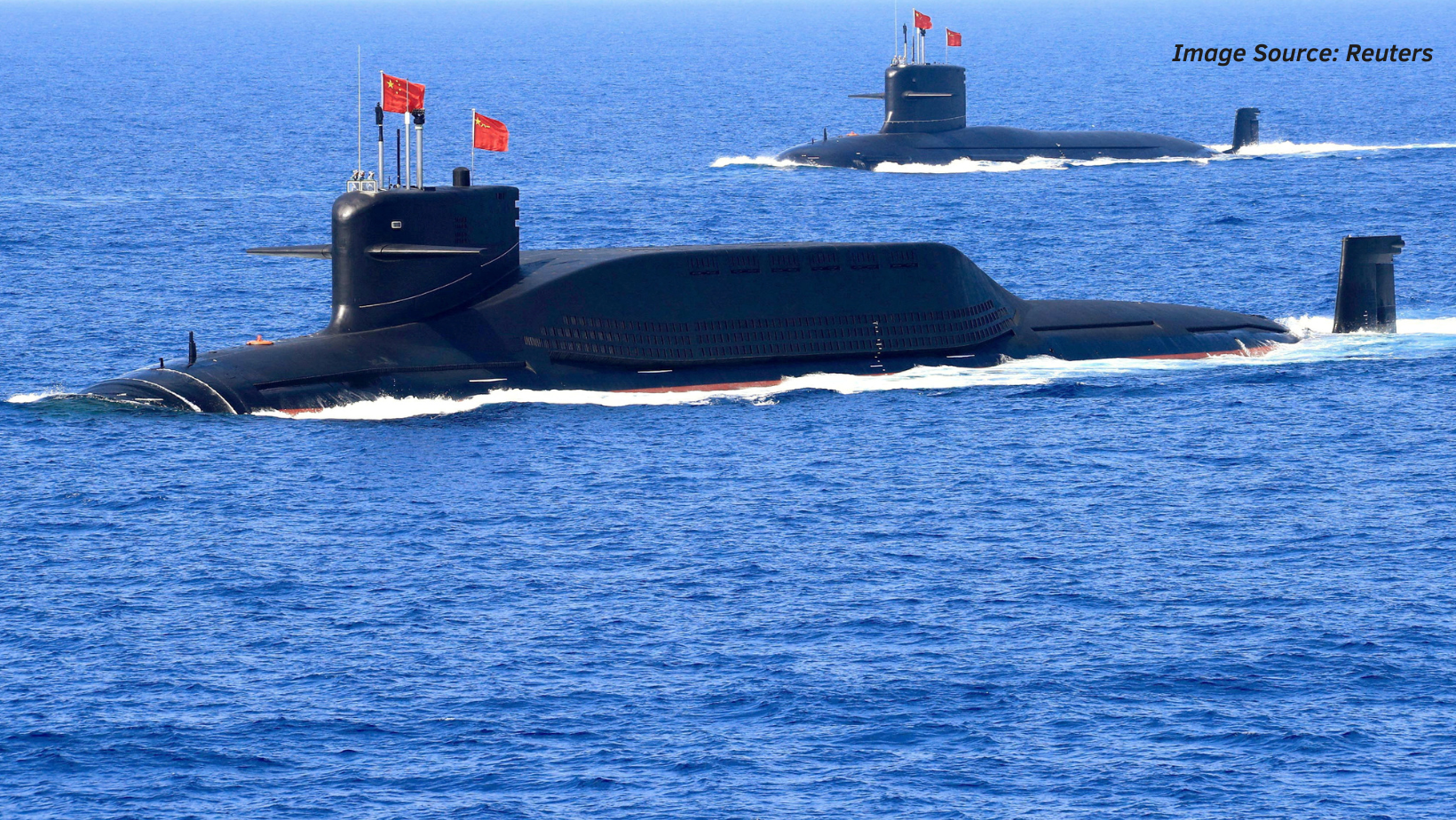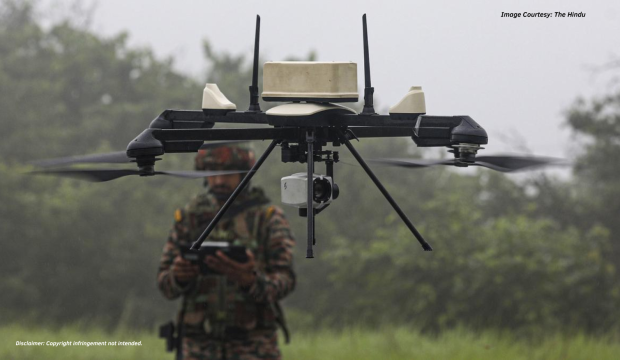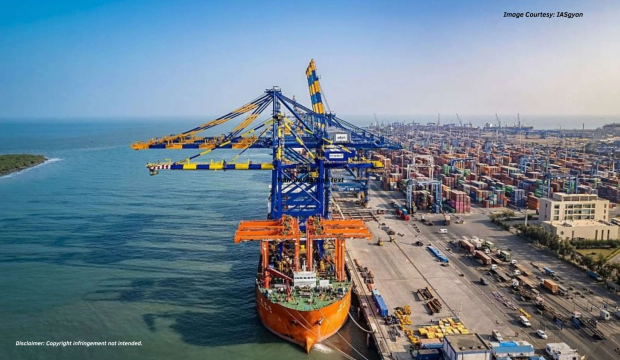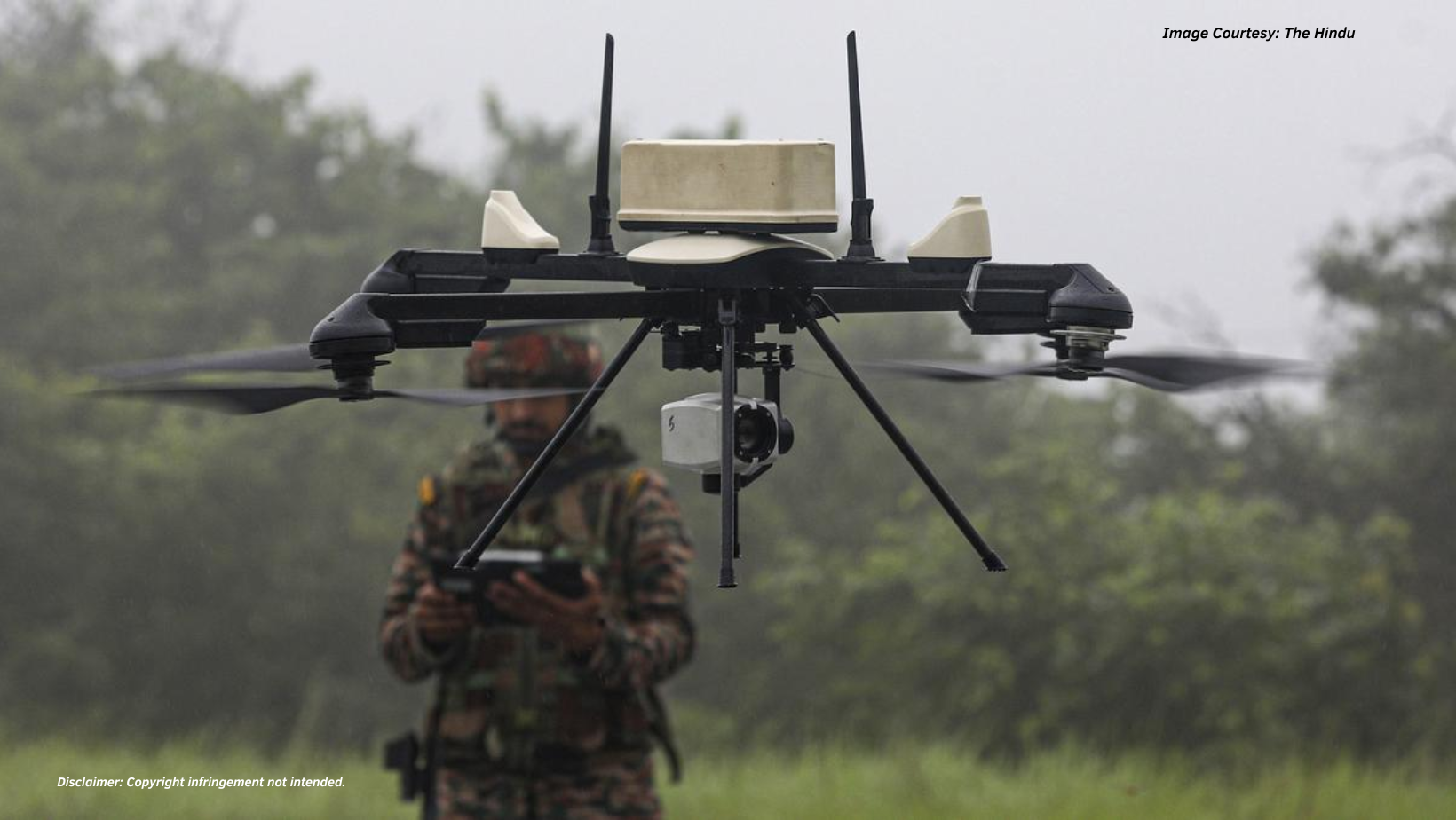Introduction
With the proliferation of technology, the rivalry between nation-states has expanded to various grounds from the outer space to sub-surface of oceans. The Deep Sea is considered to be the realm of power projection in undersea warfare. It is fought with an intention of defending coastal waters, diversified marine assets and the Sea Lanes of Communication (SLOCs), against the threats posed by the submarines and other undersea systems.
Over the years, the narrative on the global powers in the Indo-Pacific has become the focal point of discussion. It remains to be a crucial region for world nations to have strategic leverage in order to enhance their geopolitical influence and thereby alter the discourse of international politics. However, the region witnesses the presence of a key player- the People’s Republic of China (PRC) beyond its surface level. At recent times, there is a substantial increase in China’s underwater capabilities, notably, in South China Sea (SCS). More importantly, these underwater platforms of China are not restricted to SCS, but also an extended underwater presence in the Indo-Pacific region.
This expanded influence of China beyond SCS has raised concern among the regional and extra-regional powers of the world. This paper provides a conceptual understanding of underwater warfare and asses the strategic significance of the undersea environment of SCS. It also aims to examine the potential implications for Indo-Pacific, due to China’s extended underwater footprint via SCS.
Understanding Underwater Warfare:
The contemporary world has been facing a varied arena of threats that has expanded deep down the ocean. Underwater Warfare, also known as Undersea Warfare is the employment of underwater platforms such as submarines, torpedoes, mines and underwater drones in the underwater domain to conduct strategic and tactical military operations.[1] The operations can be both offensive and defensive, that includes, collection of hydrographic data.[2] through surveillance or neutralising the enemy by destroying the undersea infrastructures.
Submarines :
Submarines play a massive role in underwater warfare and are classified as conventional and nuclear submarines. Conventional Submarines or SSKs are the diesel-electric submarine, powered by battery and fuel, hence, their range of endurance to operate underwater is constrained. Contrarily, nuclear-powered submarines or SSNs are “steam driven” and has high potency to operate effectively in deep ocean. Likewise, SSBNs are the nuclear submarines that carry ballistic missile and are employed in strategic naval operations. SSNs and SSKs, however, are preferred over SSBNs for tactical operations, as they are exceedingly slow and quiet, making them difficult to detect.[3] On top of that, they also serve as a platform for laying the weapon systems such as torpedoes and mines.
Torpedoes: Torpedoes are “self-propelled weapons with an explosive warhead, launched above or below the water surface, propelled underwater towards a target, and designed to detonate either on contact with its target or in proximity to it.”[4] Modern torpedoes are distinguished as follows: in terms of their calibre- they are divided into heavy and light torpedoes; in terms of the power mode- they are divided into electric and thermodynamic torpedoes; in terms of guidance- they are classified into unguided, self-guided, line guided and composite guided torpedoes.[5]
Mines :
Mines are the explosive devices placed underwater to destroy submarines and surface ships.[6] They are known to be the, “potent Ship killers.”[7] Unlike submarines, mines are economic, easy to lay and very hard to detect and sweep. They are categorized based on the depth they are laid in. Drifting or floating mines are positioned just below the water surface and are activated by the electric, magnetic and acoustic waves released by the passing vessels. Moored or buoyant mines are rested to the bottom of the seabed and it detonates in contact with a vessel. Bottom or grounded mines are buried under the sediment layers and are difficult to locate.[8]
SOSUS and SONARS: With the evolution in underwater warfare, the need for timely detection of undersea threats was highly prioritized. Submarine monitoring and detection is the exclusive domain of Anti-Submarine Warfare (ASW). They are detected on the basis of sound propagation and disturbances caused by them to the earth’s magnetic field. Radars and high resolution satellite imagery are also used to detect the surfaced submarines.[9] During the cold war era, Sound Surveillance System (SOSUS) was the prominent mechanism that traces the submarines by their obscure acoustic signals.[10] Similarly, Sound Navigation and Ranging System (SONARS), detects the submarines and other underwater weapons, with sound waves radiated by it. There are types of Sonar devices, namely, active and passive sonars. Active sonars pass a subsurface wave and listens to the echoes emitted by an object. On the other end, passive sonars listen the radiated signals transmitted by an underwater marine object.[11]
China being an emerging power, has expanded its essential underwater forces to counter the potential power projection of US in the East Asian theatre. Currently, China owns a fleet of fifty-nine submarines[12] and is known for its SSNs with Air-Independent Propulsion system. Recently, it had also developed an ultra-fast Boron-powered supersonic missile, that acts as a torpedo in deep water.[13] It carried out the largest mine warfare exercise in 2018, which facilitated its expansion into the South China Sea.[14] In parallel with offensive underwater platforms, China had also strengthened its underwater surveillance systems. For instance, it has developed a quantum radar to detect the submarines.[15] In this manner, Beijing has taken crucial steps to project its power in its underwater domain.
Impact of Unmanned Underwater Vehicles (UUVs):
With the evolution in submarine technology, UUVs or Underwater drones, have become an important asset of underwater warfare. UUVs are the submersible vehicles that can operate underwater without human supervision. UUVs conducts ISR missions in battlespace, enhancing situational operations and tactical picture developments.[16] Based on their mode of operation, UUVs are categorized into Autonomous Underwater Vehicles (AUVs) and Remotely Operated Underwater Vehicles (ROVs). AUVs are self-propelled and distinct from ROV by maintaining a degree of autonomy of human control.[17] In common, UUVs use active sonars to detect the enemy vessels and submarines. Because they can operate autonomously in shallow waters at long standoff distances and have a high degree of stealth, UUVs are ideal for gathering information.[18]
Over the years, there has been a major shift in UUV technologies from defensive to more offensive roles. Correspondingly, UUVs play a vital role in antisubmarine warfare (ASW), tracing the movement of enemy submarines by monitoring the sensors placed on the sea floor. They can track down their adversaries, detect and destroy mines, hunt down submarines and map the ocean floor.[19] A network of UUVs is more threatening because it can operate independently, perform high-level processing, and communicate with other submerged fleet members and eventually, identify and classify the enemy assets like submarines before delivering the information to a command and control centre or conducting their own prosecution.
China has prioritized the development of underwater capabilities to resist the maritime territorial disputes in East and South China Seas. In the recent years, Beijing has accelerated its development of UUVs enhanced with following systems: “Zhishui-3 UUV prototype with dual-tail propellers and two-cross tunnel thrusters; SPC-3 robofish UUV protype; Haiyan glider type; bionic flapping-wing UUV; flexible double-tail fin UUV and UUVs armed with torpedoes.”[20] These evolving platforms tends to heighten the complexity of underwater battlespace and alter the status quo.
Underwater Developments and Strategy of China:
Liu Huaqing, the visionary of People Liberation Army Navy (PLAN), has laid down the strategic roadmap of PLAN to become “blue-navy with global influence by 2050.”[21] In relevance to it, Beijing has been steadily investing in building up its navy with strong operational capabilities on, above and below the ocean surface.
Submarine: People’s Liberation Army Navy (PLAN) controls the third largest submarine fleet in the world, possessing a total of 59 submarines. The majority of its submarines are powered by diesel electric. It owns six Jin-class (Type-094) ballistic missile submarines (SSBNs) and six Shang-class (Type- 093) nuclear powered attack submarines (SSNs). Nonetheless, conventional submarines are the backbone of PLAN’s Submarine Force. There are 17 Yuan-class (Type 039), 13 Song Class and 15 Ming- class, diesel-electric submarines (SSKs).
Notably, half of these conventional submarines are enabled with Air-Independent Propulsion system that increases its durability to function underwater.[22]
UUVs: Information regarding PLAN’s UUV programmes is not publicly accessible. UUVs are however, considered to be the force multipliers of PLAN. Since 1980s, Beijing had begun its undersea vehicle research. Chinese UUVs are categorised as cabled underwater vehicles (ROVs), autonomous underwater vehicles (AUV) and manned submersibles (HOV). “Hai Ren No. 1” (HR-01) is the first ROV of China.[23] It has massively developed a varieties of AUVs namely, Sea-Whale 2000, Qianlong, Haishen, Haiyi, Weilong series that are assigned for undersea surveying and mapping.[24] At the NAVDEX 2023, it had revealed its new heavily armed extra-large unscrewed underwater vehicle (XLUVV).[25] It is designed with four torpedo to enhance its offensive capacity with an anti-submarine role.[26]
Underwater Sensors:
To counter, the US’s SOSUS in Indo-Pacific region, China had launched its “Underwater Great Wall Project.” This project aims to build a series of underwater sensors that traces the real-time location of ships and submarines. It is a multi-dimensional project, that protects China dually from both traditional and non-traditional security issues.[27]. These sensors will be deployed at the depths of about 2000 meters beneath the sea level. It is unclear about the borders in which this underwater monitoring system will be deployed. But, there are potential chances of China extending this underwater surveillance network beyond its area of jurisdiction.

Source: Good Wind Ears: China’s Underwater Great Wall, Covert Shores.
Apparently, Beijing has no single underwater strategy, as each of the underwater platform differs by its function. In 2019, Chinese Maritime Strategist Hu Bo quoted that “in order to achieve an effective military presence in both oceans, PRC should consider deploying two ocean going fleets, centered around aircraft carriers- the Pacific fleet and the Indian Ocean Fleet.”[28] It is evident that China follows a ‘two-ocean strategy’ to increase its influence in the Indo-Pacific. Accordingly, the above mentioned undersea platforms are essential for establishing its fleets in Indian and Pacific Ocean.
In the mid-2000s, China’s naval strategy, witnessed a shift from “near-seas active defence” to “far seas operations.” In relevance to that, PLAN employs the strategy of “sea control” in SCS and “sea denial” in far seas.[29] Chinese SSNs and SSKs provides both near sea defence in first island chain and far sea protection in its second and third island chains. Deterrence is the main strategy behind Chinese SSBN fleet deployed in the SCS. UUVs provides near sea defence denying the presence of adversary, in SCS and Indian Ocean. China’s strategy is highly related to its objective to establish a blue water navy. Thus, the extended presence of these platforms in Indo-Pacific, outcasts the long-term ambitions of PLAN.
Strategic Significance of Underwater Domain in South China Sea (SCS):
South China Sea (SCS) is one of the most contentious region of the world. It covers a maritime space of 3.5 million sq. km. It is semi-enclosed by six nation-states, namely, Brunei, China, Indonesia, Malaysia, Philippines and Vietnam.[3] The land area is organised into six major groups of islands, that includes, the Paracel Islands, the Spratly Islands, the Pratas Islands, Scarborough Shoal, Macclesfield Bank and the Natuna Islands.[31]. Essentially, whoever has dominance over SCS, can control over East Asia in future. Using the three variables of economy, politics and the military, one can comprehend the strategic significance of the region.
Economic : Indo-Pacific is the home to half of the world’s busiest shipping lanes. Notably, SCS is one of the main economic arteries of the former, strategically connecting Indian and Pacific Ocean. Annually, more than 50 percent of world’s trade worth 5 trillion dollars transits through SCS.[32] Some of the most significant commodities traded through these shipping lanes includes oil and natural gas. About, one-third of total gas originated from West-Asia is transhipped from the Strait of Malacca into the SCS. In terms of natural resources, the waters of SCS, consists of rich fisheries and untapped oil and natural gas reserves. The US Energy Information Administration’s analysis of SCS, highlighted that about 11 billion barrels of oil reserves are identified in the region.[33] Around twelve percent of world’s fishing is produced in this region.[33] The proximity towards the ASEAN market is another factor that amplifies the economic significance of the region. Therefore, in addition to financial security, it is crucial for China’s energy and food security.
Political : Accompanied with the economic value, the SCS has gained political aspect in relevance to the exploitation of natural resources beneath the sea. This complicated series of territorial claims and contestations involves six countries. Firstly, China lays its historical and archaeological claims on the large area of Spratly and Paracel Islands and all of the SCS. In a way to enforce its claims, Beijing had established artificial islands and had occupied several islands and reefs in Paracel and Spratly Islands. The Philippines and Vietnam lay claims to many of the Spratly Islands by occupying it. Malaysia firms its claims upon southern Spratly Islands through occupations. Brunei has no occupation, but claims over larger area of the islands. Indonesia doesn’t claim but has an overlapping maritime zone or Exclusive Economic Zone with China and Vietnam. Along with this regional politics, albeit US has no claims in SCS, it demonstrates its presence by setting up naval units near the islands and maintaining diplomatic ties with bordering states of the SCS.[35]

Source: The UNCLOS and the US-China hegemonic competition over the South China sea, Journal of East Asian Studies.
Military: SCS is a hotspot for territorial disputes between the regional and extra-regional powers of the world. Since 2009, the region has been steadily militarized by China as it considers SCS, to be the buffer zone for the southern mainland. From the security perspective, China’s principal interest in SCS is to ensure secure bastion for the deployment of its SSBNs, for which it has been resolute in occupying all the disputed islands and challenge the presence of enemy warships in its “territorial waters.”.[36] According to Pentagon, PLAN’s Southern Theatre, in charge for naval operations in SCS, comprises of the following underwater capabilities of four SSBNs, two SSNs, 16 conventional submarines, mines and other ISR support technologies to maintain the underwater supremacy in the region. In turn, to maintain the status quo, other regional states, Brunei, Vietnam, Indonesia, Philippines and Malaysia has modernized its naval and coastal capacities in the region. Extra-regional powers such as US, Japan, France, UK and Australia has added the international dimension to the conflict, by intensifying their military presence, setting up military installations and conducting joint military exercises with the regional states, to counter the rise of China in SCS. US had improved its balance in the SCS by establishing temporary naval bases and conducting consecutive Freedom of Navigation Operations (FONOPs). Additionally, under US-Philippine Security Agreement (2016), US had set its naval units adjacent to Clark Fields. It also has its logistics base in Singapore, in proximity to Malacca Strait.[37] For instance, in 2017, Japan and US had conducted a Passing Exercise (PASSEX) in the SCS, to enhance the interoperability and secure its communication. Similarly, in the year 2018, UK and France had undertaken a joint FONOP near the Chinese possessions in Spratly islands, apparently, challenging the Chinese claim in the SCS.[38]
Given the importance of the region to the world economy, it is reasonable to assume that any instability in SCS, will have a ripple effect over the entire globe. Additionally, the region’s economy coupled with politics and the military will result in an enduring global repercussions.
Extended Undersea Presence of China in the Indo-Pacific:
The Indo-Pacific region has become more significant for China’s strategic interests. The latter is attempting to exist its control over the waters of SCS and the East China Sea (ECS), with an aim to exert its control over the western Pacific and Indian Ocean. In the year 2008, PLAN’s submarine fleet had conducted 12 patrolling operations close to Taiwan, Japan and South Korea.[39] Contemporarily, China had deployed its submarine fleet between Hainan and Woody Island in the SCS region. With the continuous deployment and patrolling by China’s submarine fleet the SLOCs in the SCS and eventually in the Indo-Pacific, will encounter a serious threat. Likewise, in 2018, Japan had identified the presence of Type 093 Shang class SSN near the Senkaku Islands in the ECS[40]. More recently, in May, 2023, PLAN’s submarine Type-094 SSBN sailed in the Philippines Sea, 800 Km from Guam[41]
Under the pretext of anti-piracy operations, while securing its strategic interests, Chinese PLAN submarines has out shown its presence in the Indo-Pacific region. Since 2009, as a part of anti-piracy operation, the PLAN had started deploying its submarines in the Arabian Sea of Western Indian Ocean. Moreover, it had not only patrolled SLOCs located in Arabian sea but also in the Bay of Bengal. In 2012, about 22 visits of Chinese Submarine were reported near the Andaman and Nicobar Islands, South of Sri Lanka and near East African coast[42]. To enhance its maritime connectivity, over the last decade, China had sponsored for about 35 ports in the world, out of which three ports are located in the Pacific Ocean and 14 ports in Indian Ocean [43]. Since 2016, the Indo-Pacific had begun to witness China’s UUVs presence in the SCS. Between 2016-2020, several Chinese UUVs were captured by the fishermen of Vietnam and Indonesia. By 2019, a dozen of Haiyi (or Sea wing gliders) UUVs were captured from the Eastern Indian Ocean, that is, near the waters of Bay of Bengal region.
Beijing had also planted underwater sensors in two-strategic places of Western Pacific. One among the acoustic sensors is located in the Mariana Trench and the other is placed in the Federated States of Micronesia.[44] According to Namrata Gowswami of IDSA, China has also build SIGINT electronic listening stations in the Andaman sea at Manaung, Hainggyi, Zadetkyi and the Coco Islands in Myanmar, to overlook the activities of submarines and UUVs deployed in the Indian Ocean[45]. Apparently, China is seeking to seize control over the second and third island chains while expanding its influence beyond the first island chain.
Implications of China’s Underwater Presence in the Indo-Pacific:
As china’s subsurface presence is steadily increasing over time, the Indo-Pacific region has become the focal point for undersea competetion. Consequently, Beijing’s assertive role in the underwater domain will have huge implications on the Indo-Pacific. According to Dr Amit Ray, China’s expanding SSBN force may affect the crisis stability.[46] of the region. In simple words, amidst worst-case scenarios, there are risks of using these nuclear weapons earlier than necessary.[47]
In 2019, almost half of the China’s energy imports were transported from West Asia .[48] However, the former is heavily dependent on SLOCs through the Indo-Pacific, in spite of the overland pipelines to import oil and natural gas. In the past decade, to overcome the “Malacca Dilemma”, PLAN submarines has shown significant presence near the Strait of Malacca. The underwater capabilities of China have the capability to interdict SLOCs that affects the global energy security and shifts the existing power of balance in the region.
In parallel with China, the regional and extra-regional powers are improving their undersea capacities that will impact the “water space management,”[49] in SCS and the Western Pacific.[50] Almost, 90 percent of global communication depends upon the undersea submarine cables. The Chinese UUVs have the capacity to physically disturb the undersea cables, disrupting the world wide communication.[51]
There has been a sharp rise in China’s interests over SCS and Taiwan. By establishing bastion in SCS and reunifying Taiwan, China can overcome the geographical limitation for its submarine movement. Contrastingly, these intentions of China violate the principle of freedom of navigation.[52]. On the other hand, China’s establishment of ports as a part of its Belt and Road Initiative, will facilitate the existence of underwater systems, that will have security implications over the regional countries like India, Japan and Australia. Consequently, China’s underwater activities intensifies the threat perceptions and prevailing rivalries of other countries in the Indo-Pacific region.
Conclusion
The critical aspect of underwater from the Indian Ocean to the Pacific Ocean has been improving dramatically, in accordance with the recent advancements in technology. Initially, Beijing had undertaken a rapid modernization of PLAN to enhance its strategic posture in the SCS. Eventually, it has altered its ambitions to establish a world-class navy. Underwater platforms like submarines, torpedoes, mines and UUVs supports its mission and facilitates the former to exert its extended influence all over the entire region. Contrarily, China’s growing capabilities in underwater warfare have significant impact on the Indo- Pacific. They challenge the balance of power in the region, raise concerns about the multiple aspects of maritime security, effects the freedom of navigations and impacts the nuclear deterrence. In response to China’s evolving capabilities, countries in the Indo-Pacific has been deepening their defence partnerships and improving their underwater capabilities. Though these efforts tend to maintain the balance in the region, it would ultimately result in arms race between the nations. Consequently, the strategic competition in underwater warfare between china and other regional powers will shape the security dynamics of the Indo-pacific in the foreseeable future.
References
- Bryan Clark,“The Emerging Era in Undersea Warfare.” Centre for Strategy and Budgetary Assessments, 2014. Accessed on 8 June 2023. p. 1-21.
topography of the sea floor, underwater currents, temperature, salinity and other hydrological information
- Michael, and Charles, “Submarine Proliferation and Regional Conflict.” Journal of Peace Research,1995. Accesed on 9 June, 2023. p. 79-95.
- Solarnavigator, “Torpedoes”. http://www.solarnavigator.net/torpedoes.htm. Accessed June 11, 2023.
John Pike, Chinese Navy- Torpedoes. 10 March 2021. https://www.globalsecurity.org/military/world/china/torpedoes.htm. Accessed on June 21, 2023.
Veerabhadraiah, Dr. Purnachandra Rao, “Underwater Mines- Past, Present and Future.” International Journal of Advance Research in Science and Engineering 5 (01), 2016.Accessed on June 20, 2023. p. 1-8
Robert Sherman and John Pike,FAS Military Analysis Network, 12 December 1998. Accessed on 20 June 2023.
Geneva Call, “Naval Mines and International Humanitarian Laws.” 5 Veerabhadraiah, Dr. Purnachandra Rao, “Underwater Mines- Past, Present and Future.” International Journal of Advance Research in Science and Engineering 5 (01), 2016.Accessed on June 20, 2023. p. 1-8April 2019. https://www.genevacall.org/naval-mines-and-international-humanitarian-law/#_edn10. Accessed on 21 June 2023
- NTI, “Submarine Detection and Monitoring: Open-Source Tools and Technologies.” 2 March 2021. https://www.nti.org/analysis/articles/submarine-detection-and-monitoring-open-source-tools-and-technologies/. Accessed on 27 June 2023.
- Global Security, “Sound Surveillance System (SOSUS).” https://www.globalsecurity.org/intell/systems/sosus.htm.. Accessed on 27 June, 2023.
- David Finch. 2011. “Comprehensive Underwater Domain Awareness: A Conceptual Model.” Canadian Naval Review 7 (3). https://www.navalreview.ca/wp-content/uploads/CNR_pdf_full/cnr_vol7_3.pdf. Accessed 27 June 2023. pp. 1-48.
NTI, “China Submairne Capabilities.” 6 March 2023. https://www.nti.org/analysis/articles/china-submarine-capabilities/. Accessed on 29 June, 2023.
Stephen Chen. “Chinese scientists plan boron-powered supersonic missile that can fly and swim.” 13 September 2022. Accessed on 27 June, 2023.
Greg Mapson. “The looming threat of sea mines.” 15 April 2020 https://www.aspistrategist.org.au/the-looming-threat-of-sea-mines/. Accessed on 22 June , 2023
Sebastin Roblin. “Can China’s Quantum Radar Detect Any Submarine” 26 December 2021. https://nationalinterest.org/blog/reboot/can-chinas-quantum-radar-detect-any-submarine-198560. Accessed on 27June, 2023.
- Zhao, Tong. 2018. Tides of Change: China’s Nuclear Ballistc Missile Submarines and Strategic Stability. Carnegie–Tsinghua Center for Global Policy, Carnegie Endowment for Peace, Carnegie Endowment for Peace, 1-120. Accessed June 20, 2023.
Abhijit Singh. “Unmanned and Autonomous Vehicles and Future Maritime Operations in Littoral Asia.” ORF Special Report (19). 2016. https://www.orfonline.org/research/unmanned-and-autonomous-vehicles-and-future-maritime-operations-in-littoral-asia/. Accessed on 21 June, 2023. p.1-16
- Rajesh Uppal, “Emergind Unmanned Underwater Vehicle Threat.” 16 February 2023. https://idstch.com/military/unmanned/emerging-unmanned-underwater-vehicleuuv-threat/. Accessed on 24 June, 2023
Silviya Mishra, “Could unmanned underwater vehicles undermine nuclear deterrence?” 8 May 2019. https://www.aspistrategist.org.au/could-unmanned-underwater-vehicles-undermine-nuclear-deterrence/. Accessed on June 24, 2023.
- Michael Kristen Lyle. “Emerging Trends in China’s Development of Unmanned Systems.” 2015. https://apps.dtic.mil/sti/pdfs/ADA616066.pdf. Accessed on June 24, 2023. p.1-15
- Ibid n.27
Ibid n.12
Perma, “Demystifying the “heroes” of China’s sea exploration, the cute “clownfish” has become the biggest Internet celebrity.” 28 June, 2019. https://perma.cc/W537-QT8C. Accessed on 5 July, 2023.
- Ryan Fedaisuik “China’S Growing Fleet of Autonomous Underwater Vehicles.” 17 August 2021. https://cimsec.org/leviathan-wakes-chinas-growing-fleet-of-autonomous-undersea-vehicles/. Accessed on 7 July, 2023.
- Ashish Dangwal. “China Unveils Extra-Large, Heavily Armed Drone Submarine That Can Attack Foreign Warships In Stealth Mode.” The Eurasian Times. 23 February 2023. Accessed July 7, 2023.
- H.I. Sutton, “China Reveals New Heavily Armed Extra-Large Uncrewed Submarine.” 23 February 2023. https://www.navalnews.com/event-news/navdex-2023/2023/02/china-reveals-new-heavily-armed-extra-large-uncrewed-submarine/. Accessed on 23 July, 2023.
- Dolma Tsering, “China’s ‘Undersea Great Wall’ Project: Implications.” 9 December 2016. https://maritimeindia.org/chinas-undersea-great-wall-project-implications/. Accessed on 30 June, 2023.
- Christopher K. Colley A Future Chinese Indian Ocean Fleet? 2 April 2021. https://warontherocks.com/2021/04/a-future-chinese-indian-ocean-fleet/. Accessed on July 3, 2023.
- Ibid n.27
- Pooja Bhatt, . “Nine Dash Line : Deciphering the South China Sea Conundrum. New Delhi: Centre for Air Power Studies.” 2020. Accessed on 27 June , 2023.
- Benjamin J Sacks, 2022. The Political Geography of the South China Sea Disputes. Research Primer, RAND.Accessed on 28 June 2023. p.1-32
- Ibid n.21
- Ibid n.21
Adam Greer, “The South China Sea Is Really a Fishery Dispute.” 20 July 2016. https://thediplomat.com/2016/07/the-south-china-sea-is-really-a-fishery-dispute/. Accessed on 28 June 2023.
- Peter J Burgese, “The Politics of the South China Sea: Territoriality and International Law.” Security Dialogue (SAGE ) 34 (1). 2003. Accessed on June 28, 2023. p.7-10
Amit Ray, “Tracing the Undersea Dragons: Chinese SSBN Programme and the Indo-Pacific.” 2020. Accessed on June 28, 2023.
- Martin D. Mitchell, “The South China Sea: A Geopolitical Analysis.” Journal of Geography and Geology . 2016 Accessed June 28, 2023.p. 1-13
Derek Grossman,. “Military Build Up in South China Sea.” RAND. 2018. Accessed June 28, 2023. p.1-28.
- Russell Hsiao, “China’s New Submarines and Deployment Patterns: Aimed at South China Sea?” China Brief (The Jamestown Foundation). 2010. Accessed on July 3, 2023.
Ankit Panda, “Japan Identifies Chinese Submarine in East China Sea: A Type 093 SSN.” 16 January 2018. Accessed on July 2, 2023.
- Twitter, Hans Kristensen, 2 May 2023. https://twitter.com/nukestrat/status/1653125217592418304. Accessed on 2 July, 2023.
- Ibid n.27
- Ibid n.27
- Synergia Foundation, “Under the Sea.” 23 January 2023. https://www.synergiafoundation.org/insights/analyses-assessments/under-sea. Accessed on 2 July, 2023.
- Namrata Gowswami, 2014. “China’s Second Coast: Implications for Northeast India.” 19 June 2015. https://idsa.in/idsacomments/ChinasSecondCoast_ngoswami_190614. Accessed July 2, 2023.
- Crisis stability, a major component of ‘strategic stability,’ can be presumed to exist when there is less chance, that a military crisis will unintentionally be started during the peace time and when a nation has no reason to deploy a nuclear weapon first in a conventional military crisis.
- Ibid n.27
- Neeraj Jay, “ China’s Pursuit of Food and Energy Security in the Indian Ocean: Consequences for India’s Development.” Institute of Security and Development Policy. 30 June 2023. https://www.isdp.eu/publication/chinas-pursuit-of-food-and-energy-security-in-the-indian-ocean-consequences-for-indias-development/. Accessed on 5 July, 2023.
- The control of water space in ASW attack techniques, to permit the rapid engagement and effective engagement of hostile submarines while preventing unintentional attacks on friendly submarines.
- Ibid n.27
- Mizhou Kajiwarax. “Underwater Competition in the Indo-Pacific.” In Hindsight Insight Foresight: Thinking About Security in the Indo-Pacific, edited by Alexander L. Vuving, 2020.. Asia-Pacific Center for Security Studies. Accessed on 6 July, 2023.p. 191-208
- Ibid n.27














































